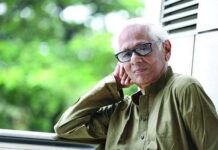Jihad Ahmed Mujstafa Diyab is a Syrian man who has been a detainee at the prison in Guantánamo Bay, Cuba, since 2002. In 2009, the Guantánamo Review Task Force ruled that he was not a threat to national security and could be released. Yet here we are five years later, and Diyab is still imprisoned at Guantánamo, having never been tried, or even accused of a crime, and with no idea when — or if — he’ll ever get out. Last year, to protest their continued confinement, he and many other detainees began a hunger strike. Most of the detainees have since given up their hunger strikes. Diyab, however, has never completely stopped his.
One reason many detainees abandoned their hunger strikes is because, twice a day, the government used what is called “enteral feeding” to ensure that they were getting nutrients. A more common term is force-feeding. The ordeal begins with something called “forced cell extraction,” which one of Diyab’s lawyers, Jon Eisenberg, described to me as “a highly orchestrated procedure.”
“A five-man riot squad in complete armor pins the guy to the floor, shackles him, and carries him out,” Eisenberg says. Then the detainee is strapped into a restraint chair — which the prisoners have dubbed the “torture chair.” One soldier holds the detainee’s head, while another feeds a tube into his nose and down to his stomach. It is very painful to endure.
Last year, I wrote several columns about force-feeding, asking whether it could be classified as torture. At the time, I didn’t think there would ever be a way to test that premise in an American court. The federal judge who seemed most sympathetic to the detainees’ plight, Gladys Kessler, had concluded that she simply lacked the authority to rule on the conditions of their confinement, based on a 2006 law intended to prevent the prisoners from petitioning the judiciary and challenging their detention.
Lo and behold, Judge Kessler turned out to be wrong. Earlier this year, the United States Court of Appeals for the District of Columbia Circuit ruled, 2 to 1, that she did have jurisdiction. There are strict medical protocols for force-feeding hospital patients or prisoners. If the military violated those protocols — especially if detainees were force-fed in an abusive, punitive manner — then she could order them to stop.
Thus began eight months of legal wrangling between Diyab’s lawyers and the government that culminated in a three-day hearing that took place earlier this month. Though no one put it like this, its purpose, at least in part, was to decide whether the military’s methods for force-feeding detainees was a form of torture.
One of those who testified on Diyab’s behalf, Steven Miles, a professor of medicine at the University of Minnesota, said it’s not even a close call. He was first horrified to discover that the government had been lubricating the tube with olive oil instead of a water-soluble lubricant. “When you pass the tube, some of the lubricant can drop into the lungs,” he said. Olive oil in the lungs can cause an inflammatory reaction called lipoid pneumonia. (The government says it stopped using olive oil as a lubricant over the summer.
After listing a half-dozen other ways the government’s force-feeding violated medical protocols, he concluded: “They turned it from a medical procedure to a penal strategy dressed up to look like a medical procedure. The procedures look nothing like medicine.”
Kessler has not yet issued her ruling, but, in the meantime, another aspect of the case has taken center stage. It turns out that the government has videotapes of Diyab enduring the forced cell extraction and the force-feeding. With some prodding from Kessler, the government was forced to allow the defense to see the videotapes.
On Oct. 8, the last day of the hearing, in a closed courtroom, both Diyab’s lawyers and the government’s lawyers played portions of the tapes, putting them into evidence. When I asked the lawyers what they saw, they told me they were not allowed to say — because the tapes are still classified.
But 16 news media outlets, including The New York Times, have petitioned the court and asked Kessler to allow the public to see the videos. In a ruling she handed down in early October, she agreed that they should be made public. But she then stayed her ruling to give the government time to decide whether to appeal it.
Diyab himself has made it clear that he would like the tapes to be seen by the public. “I want Americans to see what is going on at the prison today,” he said, according to Kessler’s ruling, “so they will understand why we are hunger-striking and why the prison should be closed.”
With any luck, the day may soon be here when we can finally decide for ourselves whether the force-feeding of Guantánamo detainees amounts to torture.
Source: NYTimes










